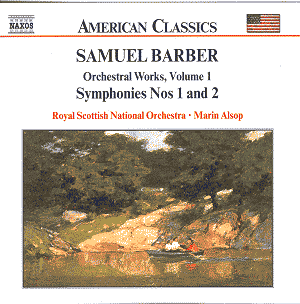Samuel Barber (1910-1981)
Orchestral Works volume 1
Overture The School for Scandal, op 5
Symphony no 1, op 9
First Essay for Orchestra, op 12
Symphony no 2, op
19
 Royal Scottish National
Orchestra/Marin Alsop
Royal Scottish National
Orchestra/Marin Alsop
Recorded at Henry Wood Hall, Glasgow, 8-9 December
2000
 NAXOS 8.559024
[69:47]
NAXOS 8.559024
[69:47]
Crotchet
Amazon
UK
Amazon
USA

This is another highly welcome instalment in Naxos's complete survey of Samuel
Barber's orchestral music.
The School for Scandal Overture (1933) was the work which put Barber
on the musical map: a jolly romp of great thematic and colourful interest.
The First Symphony (1937) is a tightly organised work, in one continuous
movement but with four distinct sections, and lasts just over 21 minutes.
The first two bustling and energetic sections are followed by an arresting
andante tranquillo section. Here, an elegiac theme for solo oboe is
gradually developed into a huge climax of passionate intensity. The concluding
passacaglia is no less powerful and is brilliantly orchestrated.
The First Essay for Orchestra (1938) is also a powerful work and is
another outstanding example of Barber's structural mastery. It opens in grave
and sombre mood but eventually a lively discourse between woodwind and strings
emerges leading to a splendid climax for full orchestra before a brief coda
returns to the opening mood.
The Second Symphony (1944, revised 1947) has a curious history. Barber was
conscripted into the USAAF in 1943 and his Air Force service was the direct
inspiration of the symphony. However, for no obvious reason (for me, it's
every bit as impressive and exciting as his first symphony) it failed to
win a place in the repertoire; eventually Barber not only withdrew it in
1964 but three years later destroyed the original score and most copies (he
did, however, retain the slow movement and published it in revised form as
a separate work, Night Flight).
The sleeve note isn't very helpful about this extraordinary decision (it
suggests vaguely 'perhaps dissatisfied with a lack of true symphonic integration'
as the reason). Fortunately a copy was found after Barber's death in 1981
and we have to thank the conductor Andrew Schenk for rescuing the work from
oblivion. Stylistically, the symphony continues to explore Barber's rich
romantic vein, but the writing is more angular and the harmonic language
more dissonant. The first movement displays enormous vigour, though eventually
coming to a reflective conclusion. The second movement takes the form of
a Nocturne beginning with a lengthy, pensive solo for cor anglais and leading
to a climax for muted strings and horns which recalls the Adagio for
Strings. The finale opens with a bustling theme for unison strings (which
bears an uncanny likeness to the opening theme to the finale of the Elgar/Payne
Third Symphony) and, like the first movement, is brimful of energy and of
Barber's trademarks as an orchestrator (stabbing brass, timpani eruptions
and so forth). Progress is interrupted to make way for a moving lament of
great beauty entrusted to the strings before the work hurtles to a rousing
conclusion.
Performance and recording are first class and this disc is a 'must' for anyone
who enjoys late-romantic music with something new to say.
Adrian Smith
See also review by Colin Clarke

